- HOME >
- Types of Tea
Producing Exceptionally Long Withered Raw Pu-erh Tea
- [2017.04.29] Posted By Akira Hojo
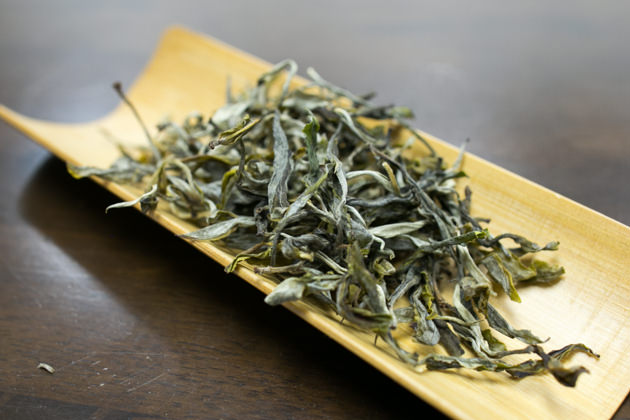
Throughout my years of tea expedition in China and meeting with unaccountable number of tea manufacturers, I learned that most of pu-erh tea manufacturers agreed that “the long withering improves the flavor of tea”. However, I have not seen any pu-erh tea that underwent very long withering. Due to various constrains in their work arrangement, it is very inconvenient for them to conduct long withering. I managed to convince one of my manufacturers who is reliable and has the good skill in process to produce the pu-erh tea with very long withering.
Process flow of raw pu-erh tea
Generally pu-erh tea is processed as the following sequence.
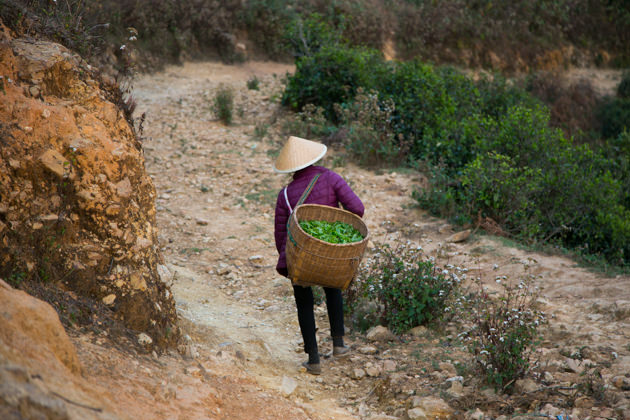
Farmers came back to their village at around 6-7pm and sell the fresh tealeaf collected in a day. Some of them bring the tea back to their home and process it by themselves. Tea is piled at about 15cm thickness and being withered until 9-10pm. In the meantime, farmers are having dinner.


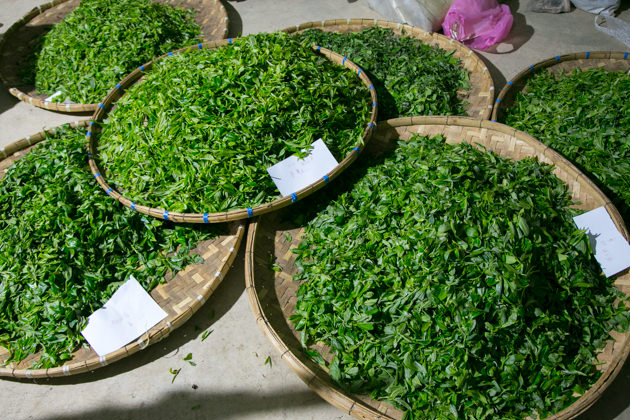
Usually, it is common that factory hires some skilled farmers to work for them at night on the part-time basis. As they are also plucking tea or working on their own farm in the daytime, they only work at the tea factory at night. As soon as after dinner, they will be back to the tea factory. I noticed that quite a number of factories hire the ladies. You may be surprised that most of the skilled tea masters are the ladies on those mountain villages.

After a few hours of withering, tea is fried on pan, slightly cooled down and rolled.

After the rolling process the tea was spread to a thin layer on the mat and leaves it overnight. In the morning, tea will be dried under the sun.

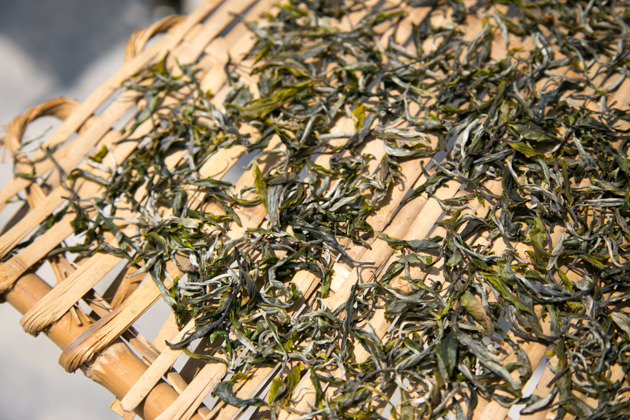
Usually, the withering process is less emphasized. The tea manufacturer pays less attention on this process in making pu-erh tea. The withering process means tea is piled at about 15cm height in the dry environment to let tea leaves gradually evaporate the moisture. The dehydration stress activates the oxidative enzyme (PPO) which then starts the moderate fermentation on tea substances. As a result, tea will produce sweetish floral flavor like flowers.
Difficulty to arrange the longer withering process
The withering process for pu-erh tea also plays a very important role just like that for oolong, white tea and black tea. The sufficient withering produces sweet and floral flavor and it creates richer cup characteristics and multi-layered of aroma. Unexpectedly, a number of manufacturers are well aware that the longer withering will gives tea with better flavor. They knew very well about the importance of withering to make a good pu-erh tea. Unfortunately, in most cases they are unable to carry out efficient withering due to some constrains. As fresh tealeaf is brought back to the tea processing site in the evening, if one wish to conduct long withering process it will take place until midnight or the next day. Usually, those factory workers do have to pluck tea or work in the farm during daytime, they cannot afford to stay up after midnight or work in the factory during daytime.
In the famous tea production area, tea is very popular and many people hope to get the tea. Usually, they will visit the tea gardens and wait to purchase the fresh tealeaf on the spot. The farmers do not even have to bring the tea back to the factory. Since the manufacturers are aware of the importance of withering, we often witness that they are conducting the withering process under the tree while they are waiting for other teas.

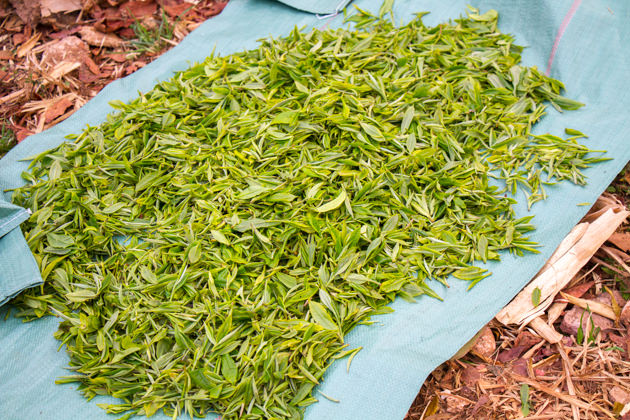
Some manufacturers conduct about 6 hours of withering
Most of the good tea gardens located far away from the village. For example it takes more than one hours walk to reach the place where tea trees are naturally grown. The pluckers will stay at the mountain until evening and bring back all their harvest to the tea factory. It’s inefficient and they are not able to collect sufficient tealeaf if they have to come back to village in the afternoon. One of my manufacturers emphasizes on the withering process more than others, and he always tried his very best to conduct longer withering. His method is that he pays more for fresh tea leaf and collect tea in the afternoon instead of evening. So the tea pluckers are willing to come back in the afternoon since he is paying more than the market price to compensate for the lost time in traveling back and forth to the tea garden. If he managed to collect tea at about 3-4pm, he can conduct withering for around six hours. He knows that the longer withered tea gives nicer flavor.
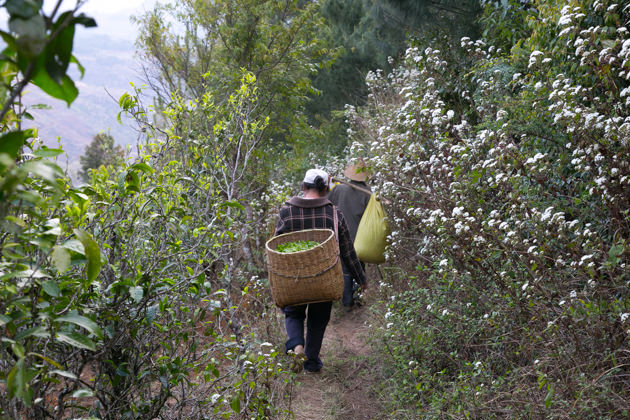
The tea garden is often located a few kilometers away from their village.
The longer the withering, the harder the pan-frying
With efficient withering process, the fresh tea leaves loss more moisture, and the pan-frying process requires higher skill. Many people thought that the pan-frying of tea means heating tea leaf with pan and inactivate the enzyme through the direct heat conduction. However, it is not in this way. The pan-frying is to evaporate the moisture of tea leaf, saturate the steam over the tea leaves and inactivate the enzyme with the heat of steam. With efficient withering process, the moisture in tea leaf is reduced. If pan-frying is not well carried out, tea leaves may either scorched or some enzymes remain active. As a result, tea undergoes further fermentation during sunshine drying process. Ironically, this kind of tea gives quite nice flavor like oolong tea. However, if we carefully judge the quality, it also has a lot of “noises” in taste, such as astringency and slightly fermented tea flavor like fresh black tea. This kind of tea is not very suitable for long term storage. After tea is being kept for a few years, the flavor turns like a over fermented black tea. It is due to the substance called thearubigin that is formed due to the remaining enzyme that is activated during sunshine drying process. The well processed tea regardless of long withering or not gives a very clear flavor and taste. When tea undergoes maturation by aging, the flavor is very clean.


Due to no fertilizer and human care, tea leaves are generally in yellowish color.

The manufacturer was amused by the outcome
Since a few years ago, I have been enthusiastically wishing to produce pu-erh tea with long withering i.e., more than 12-16 hours. I think more than 12-16 hours withered raw pu-erh tea is an unprecedented kind of tea.
This year, I discussed this project again with a skilled tea master. He has been working with us for many years. He did agree with my concept and he showed strong interest. But he said he could not arrange it due to the shortage of manpower issue. He cannot afford to run the tea production in the daytime. So I discussed with another tea manufacturer whose organization is bigger and he has sufficient number of employees and they can run the pan-frying process during daytime. Initially he was less committed on this project. But I managed to convince him to conduct the experiment to produce a few kilograms of long withered tea. I told him I will buy whichever tea he produced regardless of the outcome is good or bad.
After the experiment, we tasted the tea together with the manufacturer. The first sip tastes like a fresh raw pu-erh tea. However, its lingered finishing is vastly different from ordinary raw pu-erh tea. It gives a floral note and sweetish lingering flavor that is just like Taiwan high mountain oolong. The lingering flavor reminds me of Li Shan Cha. The person who was the most impressed by the outcome was not me, but the manufacturer. It seems he was so shocked by the result and it made him firmly committed on this project. That resulted in we managed to run the long withered raw pu-erh tea production, officially.

The photo above is the tea garden where we collected tea leaves for this project. Although it looks like a wild bush, it is actually a tea garden. We call those tea garden as Ye Fang 野放茶園 in Chinese. It means tea tree is left wild and no human care is given. Those yellowish leaves are tea trees.
We collected fresh tea from the naturally-farmed tea garden
Since we have a chance to produce this very special tea, we worked very hard to obtain good material. Usually if tea garden is located within 5-10km perimeter of the tea factory, we can identify the owners of the particular tea garden through the tea manufacturer. We committed to make a higher payment directly to the owners to ensure the fresh tea leaf is sent to our specified tea factory and not sold to other people.
Tea garden is located at around 2000-2100m. Tea is plucked once a year and no fertilizer or pesticide is used. Thanks to the high altitude and no fertilizer, tea grows very slowly. It produces extraordinarily long lasting aftertaste, multi-layered flavors and sweetness that linger for a long time on our palate.
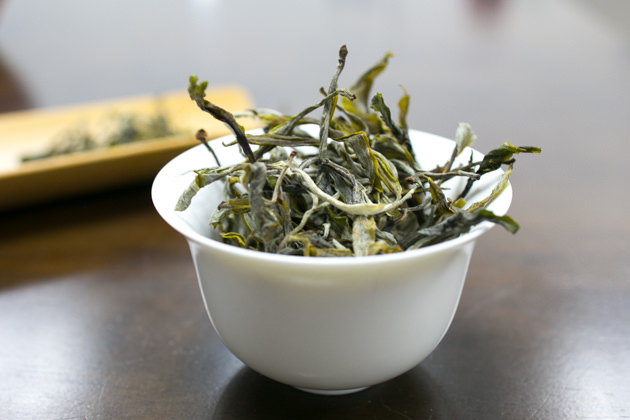
As we are delighted with the outcome, we are planning to release some mao-cha (loose tea) on a pre-booking basis. The balance of the tea will be then compressed into cake. Now we are arranging the hand-sorting process and the actual quantity is yet to be finalized. As soon as we confirm the quantity, we will release the news for pre-booking.
Related Articles
How to get the latest update on HOJO Tea?
1. Follow Twitter, 2. Click "Like" on Facebook, and 3. Subscribe in newsletter. You can have the latest tea news from HOJO Tea.
 Subscribe the Newsletter to enjoy the privileges
Subscribe the Newsletter to enjoy the privileges- You may receive a free sample upon purchase, or you may have the priority to purchase special products. So please remember to subscribe our newsletter as well as the social network.
- New Release of High Mountain White Tea
- We are pleased to introduce our High Mountain White Tea, sourced from a unique tea garden with two key features: 1. Located at an altitude of 2200-2300m2. Completely wild and untended The ideal natural conditions of this garden result in tea of exceptional quality, offering a pure and gentle, nourishing taste. High Altitude and Wild …
- New Release of Da Xue Shan Wild White Tea 2024
- We have released the 2024 Da Xue Shan Wild White Tea Loose Leaf. This tea was produced under our direct supervision during our stay in Yunnan Province, ensuring meticulous production management on site. Definition of Wild Tea in Yunnan Province People in Yunnan strongly associate Camellia taliensis with wild tea, regardless of where it is …
NEW ARTICLES
 Why Do Some Teas Taste Astringent? Exploring the Causes and Mechanisms of Astringency
Why Do Some Teas Taste Astringent? Exploring the Causes and Mechanisms of Astringency- Tea can range from having no noticeable astringency to possessing a very strong one. What causes this astringency? This article explores the causes and mechanisms behind astringency in tea. Causes of Astringency Astringency arises from the binding of tea components to proteins in the oral cavity, creating a sensation of tightness or dryness. The tongue …
 The Impact of Heat Sources on Tea Flavor
The Impact of Heat Sources on Tea Flavor- It is widely recognized that the material of a kettle plays an important role in shaping the taste of water for brewing tea. Yet, an often overlooked but equally significant factor is the type of heat source used to boil the water. Different heat sources, whether gas, electric, charcoal, or wood fire, can impart distinct …
 New Release of High Mountain White Tea
New Release of High Mountain White Tea- We are pleased to introduce our High Mountain White Tea, sourced from a unique tea garden with two key features: 1. Located at an altitude of 2200-2300m2. Completely wild and untended The ideal natural conditions of this garden result in tea of exceptional quality, offering a pure and gentle, nourishing taste. High Altitude and Wild …
 New Release of Da Xue Shan Wild White Tea 2024
New Release of Da Xue Shan Wild White Tea 2024- We have released the 2024 Da Xue Shan Wild White Tea Loose Leaf. This tea was produced under our direct supervision during our stay in Yunnan Province, ensuring meticulous production management on site. Definition of Wild Tea in Yunnan Province People in Yunnan strongly associate Camellia taliensis with wild tea, regardless of where it is …
 New Release of Wild Pu-erh Jasmine Pearl
New Release of Wild Pu-erh Jasmine Pearl- Out of curiosity, we decided to create a jasmine tea based on Da Xue Shan Wild Raw Tea. This resulted in an exceptionally rare tea, not only in Japan but also in China. Custom Production Network for Jasmine Tea At our store, we source various types of base teas from different regions during the spring. …
 2024 Overview: Our Yunnan White Tea Quality, Process, and Weather Insights
2024 Overview: Our Yunnan White Tea Quality, Process, and Weather Insights- One of the teas we’ve been focusing on in Yunnan Province is white tea. Historically white tea has been produced in both Fujian Province and Yunnan Province for a long time. While white tea from Fujian Province is well-managed during processing, we are dissatisfied with the quality of the raw materials due to the use …
 Yunnan’s Hospitality Culture: Expressed Through Meals
Yunnan’s Hospitality Culture: Expressed Through Meals- In China, as a form of greeting, it’s common to say “你吃饭了吗?” which means “Have you eaten?” However, in Yunnan Province, the phrase “吃饭” is often used in various situations, more like “Eat, eat,” serving as an invitation to share a meal. Yet, with prolonged exposure to Yunnan, one comes to understand that these meal …
 In Search of Wild Tea: Exploring Mountain Villages in Southwest Lincang, Yunnan
In Search of Wild Tea: Exploring Mountain Villages in Southwest Lincang, Yunnan- We are currently sourcing tea in the southwestern part of Lincang City, Yunnan Province. One of the crucial products for us is wild tea. While tea processing is important, securing the raw materials poses the biggest challenge. Recently, we received information about a new location where wild tea supposedly grows. To verify this, we visited …
 New Release of Anxi Traditional Oolong
New Release of Anxi Traditional Oolong- Anxi, located in Fujian province, China, is celebrated for its Tie Guan Yin tea. However, the Traditional Anxi Oolong from this region boasts a unique fruity aroma, distinguishing it from Tie Guan Yin. Anxi: A Renowned Hub for Oolong Tea Production in China Fujian Province, renowned for its rich tea heritage, boasts several prominent tea-producing …
 Yunnan 2024 Spring Tea Sourcing
Yunnan 2024 Spring Tea Sourcing- Yunnan Province is globally renowned for the exceptional quality of its tea leaves. However, lax production management often presents challenges in achieving the desired tea quality when relying solely on pre-made teas. To address this issue, we have committed to remaining on-site throughout the spring season to closely monitor tea production. We are meticulously inspecting …
Shop Info

Address:Lot No. T-215, 3rd Floor, The Gardens Mall, Mid Valley City, Lingkaran Syed Putra, 59200 Kuala Lumpur
Tel: +603-2287-4537
Business Hour: 10am to 10pm
Category
- New Arrival at HOJO Online Shop
- Featured Articles
- Newsletter
- Types of Tea
- Origin of Tea
- Teapot and Tea Equipment
- Tea Column
- How to enjoy tea
- Tea Processing
- How to choose quality tea
- Tea constituents and functional effect
- Safety of Tea
- Foods
- Tea Business Operation
- Hobby and Outdoor Activity
- Ranking of Tea
- Video
- FAQ
- Media Release
Profile

- AKIRA HOJO
- I invite you to experience my tea selections.I was born in Nagano, Japan. In university, I studied agricultural chemistry, and I have the master degree in food science. I worked in Japanese food industry for 10 years. I involved in R&D, QC and QA. As a factory manager, I implemented ISO9000 series and managed the factory.
- The Art of Tea Magazine
- We posted the article on “The Art of Tea Magazine No.9, the magazine is published in Taiwan. We featured some scientific view about the tetsubin
- New Straits Times
- The Malaysian National Newspaper, New Straits Times featured HOJO Tea on 17-Oct-2007.




















